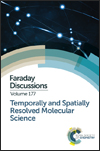Mapping atomic motions with ultrabright electrons: towards fundamental limits in space-time resolution
Abstract
The long held objective of directly observing atomic motions during the defining moments of chemistry has been achieved based on ultrabright electron sources that have given rise to a new field of atomically resolved structural dynamics. This class of experiments requires not only simultaneous sub-atomic spatial resolution with temporal resolution on the 100 femtosecond time scale but also has brightness requirements approaching single shot atomic resolution conditions. The brightness condition is in recognition that chemistry leads generally to irreversible changes in structure during the experimental conditions and that the nanoscale thin samples needed for electron structural probes pose upper limits to the available sample or “film” for atomic movies. Even in the case of reversible systems, the degree of excitation and thermal effects require the brightest sources possible for a given space-time resolution to observe the structural changes above background. Further progress in the field, particularly to the study of biological systems and solution reaction chemistry, requires increased brightness and spatial coherence, as well as an ability to tune the electron scattering cross-section to meet sample constraints. The electron bunch density or intensity depends directly on the magnitude of the extraction field for photoemitted electron sources and electron energy distribution in the transverse and longitudinal planes of electron propagation. This work examines the fundamental limits to optimizing these parameters based on relativistic electron sources using re-bunching cavity concepts that are now capable of achieving 10 femtosecond time scale resolution to capture the fastest nuclear motions. This analysis is given for both diffraction and real space imaging of structural dynamics in which there are several orders of magnitude higher space-time resolution with diffraction methods. The first experimental results from the Relativistic Electron Gun for Atomic Exploration (REGAE) are given that show the significantly reduced multiple electron scattering problem in this regime, which opens up micron scale systems, notably solution phase chemistry, to atomically resolved structural dynamics.
- This article is part of the themed collections: Temporally and Spatially Resolved Molecular Science and Celebrating the 2016 RSC Prize and Award Winners

 Please wait while we load your content...
Please wait while we load your content...